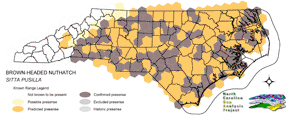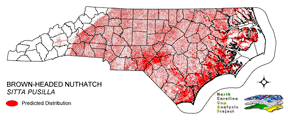
| Taxa: |
| Order: |
| Family: |
| Aves |
| Passeriformes |
| Sittidae |
| NatureServe Global Rank: |
| NatureServe State (NC) Rank: |
| G5 |
| S5 |
| Federal Status: |
| NC State Status: |
| --- |
| --- |


| Land Unit |
| US Fish & Wildlife Service |
| US Forest Service |
| US National Park Service |
| US Department of Defense |
| NC State Parks |
| NC University System |
| NC Wildlife Res. Com. |
| NC Forest Service |
| NC Div. of Coastal Mgmt. |
| Local Governments |
| Non-Governmental Org. |
| Other Public Lands |
| Private Lands |
| GAP Status 1-2 |
| All Protected Lands |
| Statewide |
| Hectares |
| 90,579.24 |
| 71,124.03 |
| 120,669.93 |
| 351.81 |
| 24,730.38 |
| 32,079.60 |
| 94,521.87 |
| 11,580.03 |
| 6,130.44 |
| 2,344.68 |
| 20,195.55 |
| 2,328.39 |
| 3,972,986.10 |
| 216,815.31 |
| 474,895.62 |
| 4,449,622.05 |
| Acres |
| 223,826.13 |
| 175,751.27 |
| 298,181.83 |
| 869.34 |
| 61,110.09 |
| 79,270.40 |
| 233,568.58 |
| 28,614.87 |
| 15,148.64 |
| 5,793.83 |
| 49,904.28 |
| 5,753.58 |
| 9,817,460.55 |
| 535,762.19 |
| 1,173,492.40 |
| 10,995,253.40 |
| % of Dist. on |
| Prot. Lands |
| 19.1 % |
| 15.0 % |
| 25.3 % |
| < 0.1 % |
| 5.2 % |
| 6.8 % |
| 19.7 % |
| 2.4 % |
| 1.3 % |
| 4.2 % |
| 4.2 % |
| 0.4 % |
| < 0.1 % |
| 45.7 % |
| ----- |
| ----- |
| % of Dist. on |
| All Lands |
| 2.0 % |
| 1.6 % |
| 2.7 % |
| < 0.1 % |
| 0.6 % |
| 0.7 % |
| 2.1 % |
| 0.3 % |
| 0.1 % |
| < 0.1 % |
| 0.5 % |
| < 0.1 % |
| 89.3 % |
| 4.9 % |
| ----- |
| ----- |
|
Potter et al (1980) lists this nuthatch as a 'common permanent resident of open pine woods throughout the coastal plain and most of the piedmont.' Simpson (1992) states its status in the mountains as a 'rare and local permanent resident in pine forests below 2,500 ft.' Absent on the barrier islands (Fussell 1994). Prefers open pinewoods (Harison 1975, Potter et al 1980), often mixed with deciduous tree species (Ehrilch et al 1988, Kaufman 1996). Hamel (1992) asserts the Brown-headed nuthatch favors mature pine stands, and is not common in dense forests. Nest is usually excavated by both sexes in a dead pine tree, although occasionally a deciduous tree or fence post is used (Kaufman 1996). According to Potter et al (1980) nest height ranges from 'a few inches to about 90 feet' above the ground, generally though it is less than 15 feet. With regard to other cavities, Brown-headed nuthatches rarely use old woodpecker holes (Ehrlich et al 1988, Potter et al 1980). Oft times the pair will begin several cavities before completing one for use (Kaufman 1996, Ehrlich et al 1988). Common lining used for the nest includes grass, bark fibers, hair, feathers, as well as the 'wings' (Kaufman 1996) and transparent sheaths (Potter et al 1980) from pine seeds. Hops along the trunk, limbs, higher branches and twigs searching, probing or gleaning, insects in crevices (Kaufman 1996). Forages mainly on insects and spiders in breeding season (Kaufman 1996), with pine seeds also occupying a large portion of their diet (Potter et al 1980). NATURE SERVE GLOBAL HABITAT COMMENTS: Pine forests, open pine woods, and pine-oak woodland, foraging less frequently in deciduous scrub, along fence rows, and in open situations with scattered trees. Occasionally in cypress swamp. Nests in cavity in dead wood, excavated by nuthatches, or a partial cavity enlarged, or an old one reused; usually less than 3 m above ground. May use bird boxes. |
| Code | Name | Description | NC Natural Heritage Program Equivalent |
| 121 | Maritime Pinelands | Loblolly forests and woodlands of the outer coastal plain. | Estuarine Fringe Loblolly Pine Forest |
| 17 | Maritime Forests and Hammocks | Maritime forests and woodlands dominated by live or sand laurel oak. Estuarine Fringe forests dominated by loblolly pine. | Coastal Fringe Evergreen Forest, Maritime Deciduous Forest, Maritime Deciduous Forest |
| 158 | Coastal Plain Nonriverine Wet Flat Forests | Loblolly pine - Atlantic white-cedar - red maple - swamp tupelo saturated forests as well as forests dominated by loblolly, sweetgum, and red maple in non-riverine flats. | Non-riverine Wet Hardwood Forest |
| 30 | Cypress-Gum Floodplain Forests | Swamps dominated by black or swamp tupelo with or without Taxodium. Seasonally to semi-permanently flooded hydrology. | Cypress-Gum Swamps |
| 78 | Pond-Cypress - Gum Swamps, Savannas and Lakeshores | Cypress dominated swamps and lakeshores. Can include bays dominated by pond cypress or shorelines of coastal plain lakes with a narrow band of cypress. | Non-riverine Swamp Forest, Natural Lakeshores (in part) |
| 87 | Pocosin Woodlands and Shrublands | Includes pond pine woodland, low pocosin and high pocosin shrub dominated areas. Canebrakes and bay forests may be present. | Pond Pine Woodlands, Peatland Canebrake, Small Depression Pocosin |
| 67 | Wet Longleaf or Slash Pine Savanna | Wet flatwoods and pine savannas, typically dominated by longleaf pines, but slash or pond pines may be the dominant pines. | Wet Pine Flatwoods |
| 97 | Mesic Longleaf Pine | Longleaf pine woodlands without a major scrub oak component. Slash or loblolly pines may be present as well. | Mesic Pine Flatwoods |
| 42 | Xeric Longleaf Pine | Sandhills including a range of longleaf pine density from predominantly wiregrass, scrub oak dominated to true longleaf pine woodland. This does not include mesic or saturated flatwood types. | Xeric Sandhill Scrub, Pine/Scrub Oak Sandhill, Coastal Fringe Sandhill |
| 46 | Xeric Oak - Pine Forests | Mixed forest dominated by yellow pines with white or northern red oaks co-dominating. | Pine Oak Heath |
| 232 | Xeric Pine-Hardwood Woodlands and Forests | Mixed forest dominated by yellow pines with drier oaks including southern red, post, and chestnut oaks. | Dry Oak Hickory Forest |
| 230 | Piedmont Mesic Forest | American Beech - Red Oak - White Oak Forests. | Mesic Mixed Hardwood |
| 383 | Piedmont Mixed Successional Forest | Generally loblolly mixed with successional hardwoods. Sweetgum, tulip poplar and red maple are common co-dominants in these successional forests. | No equivalent |
| 222 | Piedmont Dry-Mesic Pine Forests | Loblolly dominated forests resulting from succession following clearing. This type occurs on all moisture regimes following disturbance with the exception of the extremely xeric sites. | No equivalent |
| 220 | Piedmont Xeric Pine Forests | Dry to xeric pine forests dominated by Virginia pine, shortleaf pine or Eastern Red Cedar. | Pine Oak Heath |
| 226 | Piedmont Xeric Woodlands | Generally post and blackjack oak dominated woodlands. White ash and pignut hickory can be found in combination with Eastern red cedar on glades. | Xeric Hardpan Forest |
| 21 | Coniferous Cultivated Plantation (natural / planted) | Managed pine plantations, densely planted. Most planted stands are loblolly, but slash and longleaf occur as well. | No equivalent |
| 36 | Successional Deciduous Forests | Regenerating deciduous trees with a shrub stature. Commonly dominated by sweetgum, tulip poplars and maples. | No equivalent |
| 202 | Residential Urban | Includes vegetation interspersed in residential areas. Includes lawns, mixed species woodlots, and horticultural shrubs. Vegetation accounts for between 20 - 70% of the cover. | No equivalent |
| 528 | Appalachian Xeric Pine Forest | Pine forests and woodlands on xeric sites. A variety of pines, including Virginia, Shortleaf, Eastern White Pine, Table Mountain and Pitch pine. Often small areas of dense pine within a matrix of Xeric Oak-Pine Forests. | Pine Oak Heath |
| 529 | Appalachian Xeric Mixed Forest | Mixed forests with Virginia, Shortleaf, Eastern White Pine, Table Mountain and Pitch pines in combination with xeric oak species. Oaks include, white, Southern Red, black, and rock chestnut. | Pine Oak Heath |
|
Carter, M., G. Fenwick, C. Hunter, D. Pashley, D. Petit, J. Price, and J. Trapp. 1996. Watchlist 1996:For the future. Field Notes 50(3):238-240.
Bent, A.C. 1948. Life histories of North American nuthatches, wrens, thrashers, and their allies. U.S. National Museum Bulletin 195. Washington, D.C. Hamel, P. B. 1992. The land manager's guide to the birds of the south. The Nature Conservancy, Chapel Hill, North Carolina. 367 pp + several appendices. Simpson MB Jr. 1992. Birds of the Blue Ridge Mountains. Chapel Hill and London: University of North Carolina Press. Fussell, J.O. III. 1994. A birderís guide to coastal North Carolina. Chapel Hill and London: The University of North Carolina Press. Norris, R.A. 1958. Comp., biosys. and life history of Nuthatches (Sitta pygmaea and Sitta pusilla). Berkeley. 182 pp. Harrison, H.H. 1975. A field guide to bird's nests in the U.S. east of the Mississippi River. Houghton Mifflin Company, Boston, Massachusetts. 257 p. Harrison, C. 1978. A field guide to the nests, eggs and nestlings of North American birds. Collins, Cleveland, Ohio. Harrison, H.H. 1979. A field guide to western birds' nests. Houghton Mifflin Company, Boston. 279 pp. Potter, E. F., J. F. Parnell, and R. P. Teulings. 1980. Birds of the Carolinas. Univ. North Carolina Press, Chapel Hill. 408 pp. Terres, J.K. 1980. The Audubon Society encyclopedia of North American birds. Alfred A. Knopf, New York. American Ornithologists' Union (AOU), Committee on Classification and Nomenclature. 1983. Check-list of North American Birds. Sixth Edition. American Ornithologists' Union, Allen Press, Inc., Lawrence, Kansas. Ehrlich, P.R., D.S. Dobkin, and D. Wheye. 1988. The birder's handbook:a field guide to the natural history of North American birds. Simon and Shuster, Inc., New York. xxx + 785 pp. Mitchell, W.A. 1988. Songbird nest boxes. Section 5.1.8, U.S. Army Corps of Engineers, Wildlife Resources Management Manual. Tech. Rep. EL-88-19. Waterways Experiment Station, Vicksburg, Mississippi. 48 pp. |
For more information please contact them at:
NC-GAP Analysis Project
Dept. of Zoology, NCSU
Campus Box 7617
Raleigh, NC 27695-7617
(919) 513-2853
www.basic.ncsu.edu/ncgap